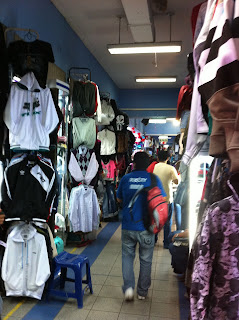Polvos Azules roughly translate as blue dust o blue powder. I don’t know why it has that name and I don’t care. This place rocks…trust me. I don't like to shop but shopping here is fun...and slightly sketchy. You feel like you are in one of those movies where some kid comes up to you saying "Mister I got what you want" He has no idea what you want but he does probably have it.
You will think you have died and gone to counterfeit heaven. It is the market in Lima where anything is possible. My favorite items to purchase in the market are CDs, movies and TV shows. The prices are cheap and the selection is wide.
You can buy a CD with 200 plus songs in MP3 format for $0.90 and each Movie or TV Show will cost slightly more than $1 per disc (A season of a TV show will have multiple discs). They really do have almost everything. I have very rarely asked for an artist or show that they don’t have. If they don’t have it…they will find it for you.
 You can buy “designer” clothes and handbags and name brand shoes that cost a fraction of the price of the real thing.
You can buy “designer” clothes and handbags and name brand shoes that cost a fraction of the price of the real thing.I do warn you about the video games and the Rosetta Stone programs…so far no luck in making those work. It is a shame too…as you can buy all five levels of a language in Rosetta Stone for 30 soles (about $11). I will keep asking about those programs.
Here you can also buy computer equipment, fix a watch or unlock a cellphone. You can really get almost anything in this market.
Some people will tell you that Polvos Azules is dangerous. I would not say that. I do think you should watch your valuables and not flash your money or phones.
The market is on the Via Expresa near downtown Lima. All the taxi drivers know how to get there.
Good luck and happy shopping!







Can't wait to check this place out.
ReplyDeleteEl nombre proviene de la calle "polvos azules" en donde está el centro comercial
ReplyDeleteEn el libro “Las viejas calles de Lima” escrito por el historiador peruano, Juan Bromley, podemos hallar la respuesta a esta interrogante. En esta obra se señala que el nombre de esta calle se habría originado nada menos que en honor a un surtidor de cueros del siglo XVI que había descubierto la forma de teñir de color azul los cordobanes (cuero de macho cabrío o cabra).